April 13, 2014 |
BITE: My Journal
Grasstronomy at Blue Hill
 Crunchy pickles arrive with a knife to cut the beet jerky.
Crunchy pickles arrive with a knife to cut the beet jerky. Yes, Blue Hill at Stone Barns is probably -- cross out “probably,” make that “definitely” -- one of the 100 best restaurants in America, perhaps in the world. That’s if you agree that El Bulli ranked tops in that rarified constellation and Noma handily edged it out. You must consider creating an egg out of a potato equals the genius of L’Ami Louis’ sublime pommes béarnaise. If, for you, rendering stems and roots crunchily edible (or even near-edible) is equal in brilliance to Jean-Georges’ devilishly citric raw sea trout and roe on lemon mousse, there is no more to say.
 The room is darkened and elegant, service very proper. Chef Dan Barber comes out to say hello.
The room is darkened and elegant, service very proper. Chef Dan Barber comes out to say hello. Before it became the mantra, before chefs tattooed it on their forearms or embroidered it on their baseball caps, Chef Dan Barber was defining farm-to-table. He’d worked on his grandmother’s farm as a boy. He shopped at the green market for his cramped and wonderful little Blue Hill below sidewalk level in the Village. Then came David Rockefeller, the last surviving grandson of the legendary oil tycoon, tapping Dan and his brother David (with wife Lauren) to run a restaurant at the family’s farm in Pocantico Hills (over Thomas Keller, David Bouley, Danny Meyer and others they’d solicited too).
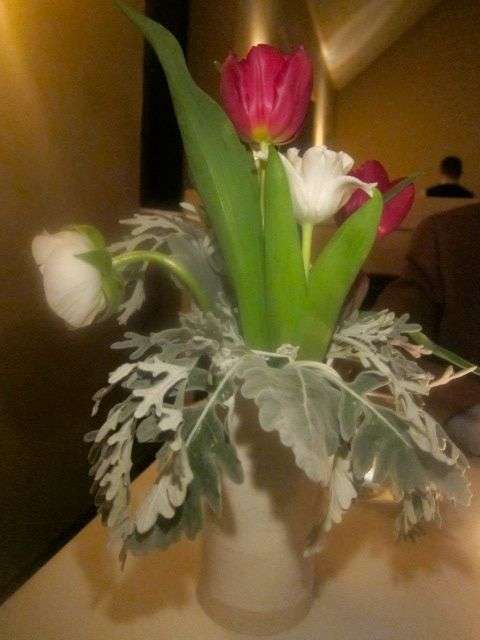 The tulips on our table are perky but the leaves seem to be swooning a little.
The tulips on our table are perky but the leaves seem to be swooning a little. Last time I tasted, a decade ago, I raved about the parsnip soup with a basil soy droplet afloat, little head cheese croquettes, local pork perfectly cooked, and braised baby lamb with Brussels sprouts leaves. It was a long drive but, in the right mood, a charming detour.
I think I knew something messianic was afoot at Blue Hill these days, but it didn’t sink in that my friends and I were signing on for a three and a half hour immersion in nature, an exercise in sustainability. I commit to drawn-out tasting performances warily these days. But tonight, the three of us were excited. An adventure. My friends had hired a driver so they could drink as much wine as they pleased and not worry about falling asleep on the way home.
 There’s still light when we arrive, a reflection, also the moon and stars from our window.
There’s still light when we arrive, a reflection, also the moon and stars from our window. The sky was just growing dark when we pulled in -- too late to tour the fields or explore the greenhouse. The extended path to the sprawling converted barn was already aerobic enough for me. I sensed that Michelin-three-star-feel, the polished detour on a country road, the warm welcome, the practiced service, art on the walls, advanced greenery, a brown velvet booth, a pretty little booklet with precious line drawings at each place listing the seasonal options to take home.
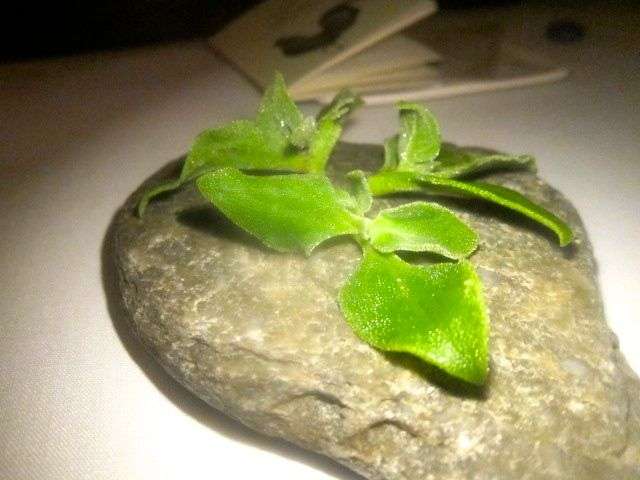 I think this is the ice lettuce. Eventually I needed an annotated menu to remember it all.
I think this is the ice lettuce. Eventually I needed an annotated menu to remember it all. I chose the $148 eight-course Farmers Feast over the $208 Grazing, Pecking, and Rooting menu (wine pairings $150). We agreed, wanting to finish at a reasonable hour. I told the sommelier I liked a fruity, friendly red for $60 or so and he recommended a $65 Pedrosa wine from the Ribera del Duero that was exactly what I had in mind.
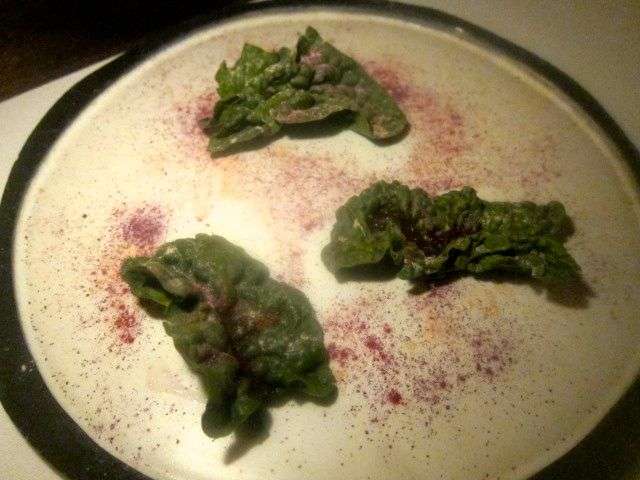 A leaf of spinach for each of us…not a clue about the red powder.
A leaf of spinach for each of us…not a clue about the red powder. Hugo, our captain, ascertains our allergies and our likes and dislikes -- sweetbreads, yes, brains, pork yes, yes. (Hugo has the grace not to introduce himself. I picked up his name from our check, $546 before tip.) Alas, my companion Marisa is allergic to shellfish, most everything that swims and everything that flies. Hugo does not seem to think that will be a challenge.
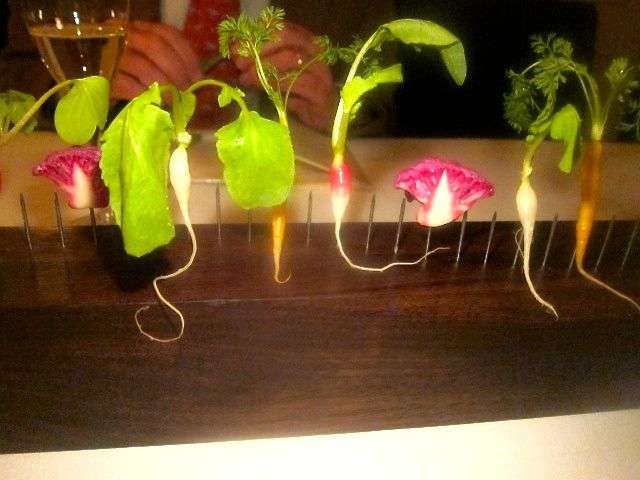 This lineup of unborn veggie is the charming curtain-raiser. Were we supposed to eat the strings?
This lineup of unborn veggie is the charming curtain-raiser. Were we supposed to eat the strings? What I would call unborn root vegetables impaled on nails on a wooden board are delivered. A charming centerpiece for a playroom lunch. The radishes have long, hair-like tails. To eat or not to eat? Miss Manners doesn’t have a clue. Ficoides glaciale, ice lettuce to you, is served on a stone, just one sprig each. Winterberry leaves follow. We are instructed to just eat the berries. One tiny berry each. Very intense. Impressive to get all that pow from one berry.
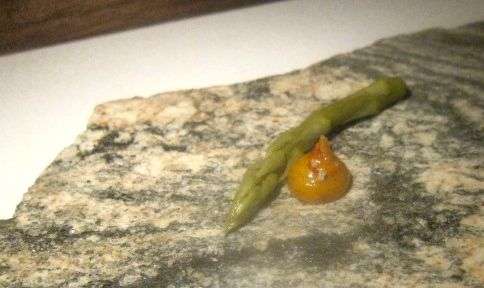 With no fresh ramps around yet, we get a preserved one with a tiny egg yolk.
With no fresh ramps around yet, we get a preserved one with a tiny egg yolk. I don’t really want to eat spinach but I’m hungry. Beet jerky, at least, is something to chew on. I’m congenitally opposed to ramps. As the first green of spring, they will soon be trumpeted everywhere. Apparently it’s too early for ramps up here. Instead we get last year’s ramps preserved -- one each -- and a small, steamed egg yolk, then pea sprouts with vinegared maple syrup, followed by shrimp with phytoplankton. Does that sound substantial? Well, it isn’t. Fortunately the shellfish-wary Marisa spies tiny shrimp eyes, and passes.
 The beet sushi is reassuring. It looks like beet. It looks like rice. It tastes like beet on rice.
The beet sushi is reassuring. It looks like beet. It looks like rice. It tastes like beet on rice. This harvest of nature’s bounty comes on rock slabs, in bowls with stones or nestled in petrified wood. That’s a design statement, a philosophical concept, but not a pacifier for my hunger. At least my worst fears, fanned by tales from Noma -- burning twigs and porcupine quills -- have not been realized.
 Cabbage and kale crisps as a work of art. “A horror story,” Marisa muses, “or a Peter Gelb opera.”
Cabbage and kale crisps as a work of art. “A horror story,” Marisa muses, “or a Peter Gelb opera.” Curried carrot tongues do not do the trick, nor even beet sushi (cute but no cigar). These little munchies are leading up to drama: flat sails of dried cabbage and kale arrive, impaled on a fence, like a bad dream or an opera by Peter Gelb, Marisa observes. What the hell. I’m hungry. The tissue-thin membranes crumble en route to the mouth.
 Caviar on sweet potato with crème fraîche. Caviar can head off a tantrum in the making.
Caviar on sweet potato with crème fraîche. Caviar can head off a tantrum in the making. This is not a flashback to Girardet dreams or Troisgros memories. Yeasted potatoes? Okay, something to chew on. And then happily, a nice plop of caviar on a turned sweet potato tower with crème fraîche. I scoop up Marisa’s caviar because she’s allergic to that too, not even offering to share the extra treat with her husband.
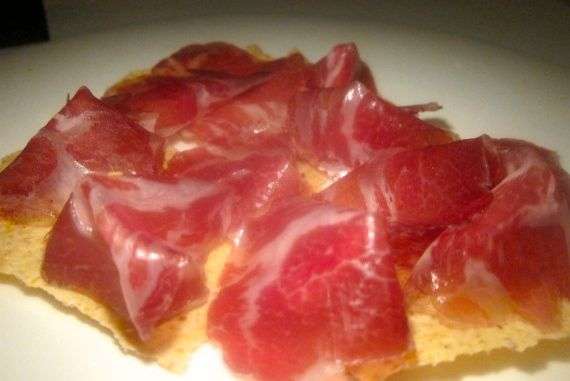 I was optimistic when the house-made coppa arrived on corn crisps: not one each, but several.
I was optimistic when the house-made coppa arrived on corn crisps: not one each, but several. You’d think that pork liver with chocolate and savory curls of house-made coppa from the farm’s own pigs on corn crisps would soothe the savage beast. Yes, but not enough. And the small triangles cut from chicken wings with green garlic. It still feels like a very long preamble.
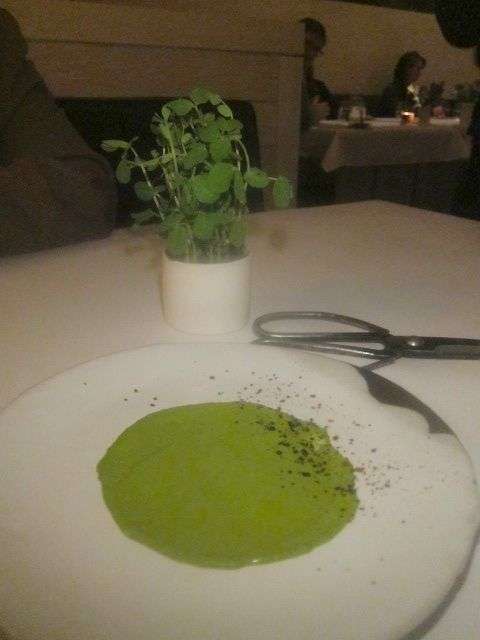 I am not a fan of do-it-yourself at the table with a scissors, although the pesto is good.
I am not a fan of do-it-yourself at the table with a scissors, although the pesto is good. Spring dandelion growing in a pot comes with scissors to cut and drag the prepubescent sprigs through a puddle of pistou. I’m not annoyed enough to stab myself or anyone else, but I never did like scissors in the dining room (even at Alain Ducasse’s Louis XV where the waiter snipped herbs to make tea). The pleasant pistou taste is chased by the old tennis socks savor of baby broccoli rabe soaked in mullet oil.
“I see people eating bread,” Marisa reports. “We should have bread too.”
Hugo politely demurs. “I think the chef has a special course planned for you that involves bread.”
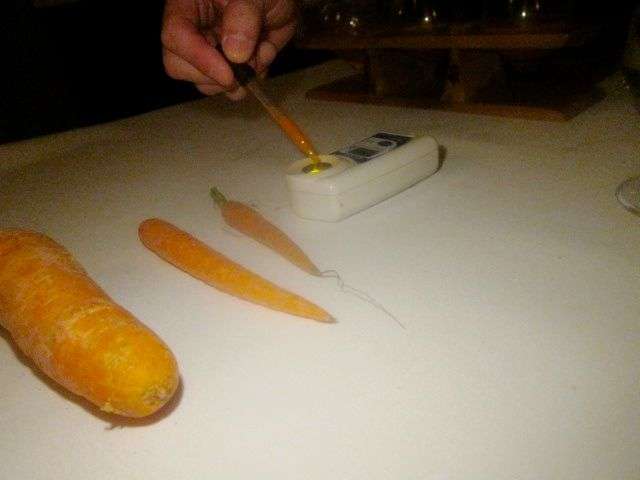 Which carrot has more sugar? As you might guess, the pampered Blue Hill carrot is the sweetest.
Which carrot has more sugar? As you might guess, the pampered Blue Hill carrot is the sweetest. First we must attend to a course in carrot appreciation. The carrot juice cocktail in our goblets must wait while we are instructed in the comparative sweetness of carrots. Three carrots are set on the tablecloth -- one ugly proletariat, a somewhat appealing middleweight, and a just-born patrician baby. Their flesh is scraped and measured on a sugar meter.
 Delicious carrot panna cotta with a mantle of nasturtium leaves does not need a stuffing of chopped tsai tsai, but if you’re sustaining the planet, someone has to eat that monstrous-looking vegetable.
Delicious carrot panna cotta with a mantle of nasturtium leaves does not need a stuffing of chopped tsai tsai, but if you’re sustaining the planet, someone has to eat that monstrous-looking vegetable. Of course the Blue Hill carrot is the winner and we are free to sip our carrot cocktail. It’s dazzling, vibrant, sublime. And a carrot yogurt panna cotta filled with pebbles of a strange vegetable called tsai tsai under a mantle of nasturtium leaves is surprisingly good, too. The tsai tsai itself, a big, ugly, blowsy thing, presented for our edification, sits on the table.
 Chef Barber glows with the excitement of developing a wheat that can thrive in drought.
Chef Barber glows with the excitement of developing a wheat that can thrive in drought. Now the Big Bread Moment. We have been summoned to meet Chef Barber in the drying shed just beyond the barn, into the loggia and the cold night air, down a few steps. It’s dark, lit only by candles. There are white flowers, a heavy silver branch, and herbs drying on the walls. The chef steps in, standing at the top of the stair in his floor length apron, an iPad in his hand.
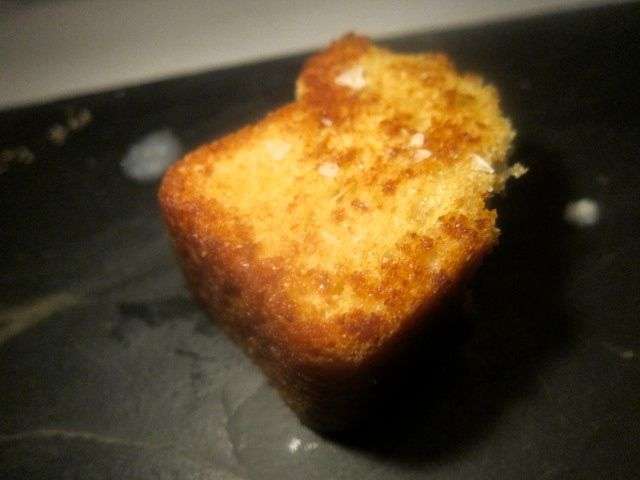 Oh how we craved bread. The buttered and toasted whole wheat brioche is thrilling.
Oh how we craved bread. The buttered and toasted whole wheat brioche is thrilling. He is glowing -- a missionary, after all -- but modest, even self-effacing. He has been growing hundreds of different strains of wheat: He shows us a photograph of his patchwork wheat field. And a close-up on the iPad of the Barber wheat that he hopes will prove to be the stalwart new species as global warming prolongs drought in the wheat belt. He mentions the Nobel Prize. Teasingly. But, why not?
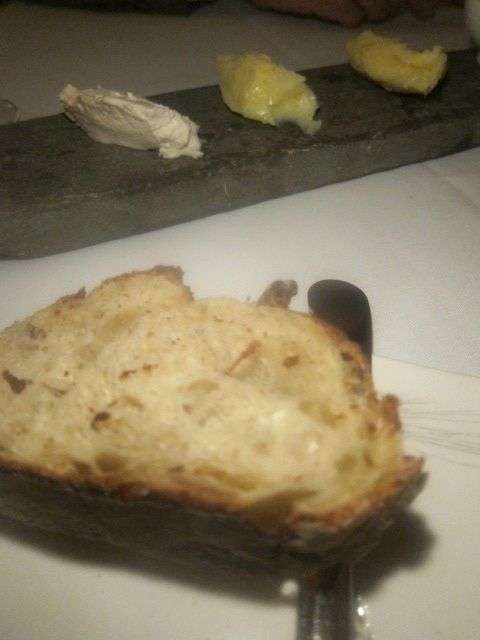 Single udder butter from Daffodil and Jillian or lard is offered with marvelous country whole wheat.
Single udder butter from Daffodil and Jillian or lard is offered with marvelous country whole wheat. A trio of waiters enter bearing bread for each of us, a thick slab of toasted whole wheat brioche, buttered with single udder butter from the Barbers’ family farm in Massachusetts. It’s either Daffodil’s butter or Jillian’s, we are told. A waiter whips some ricotta into thick little curds. This bread needs no ricotta, nothing but Daffodil’s benediction (or is it Jillian’s?). It’s marvelous. I want to carry it back to the dining room to savor it slowly. But this is not a dining room to carry your own picnic into.
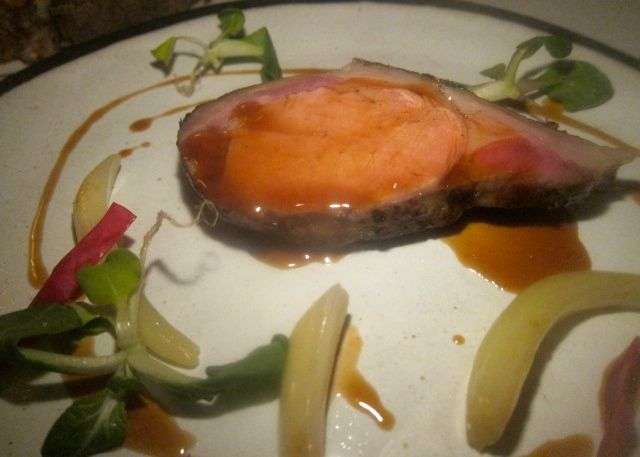 It’s late. We say we must go. Pork arrives – silken and tender – from the Blue Farm heritage pigs.
It’s late. We say we must go. Pork arrives – silken and tender – from the Blue Farm heritage pigs. Back at the table, there are ovals of Daffodil, Jillian and lard for the next course, a slice of rustic whole wheat country bread, warmed and crusty, served with greens marmalade. I finish that too, ignoring the preserved greens. And suddenly I’m so full I can’t properly tackle the house’s pampered pork, tender and silky, and definitely not the cabbage and bok choy strewn alongside.
 A tasting of seasonal honeys with vegetables is arranged on the table in a honeycomb.
A tasting of seasonal honeys with vegetables is arranged on the table in a honeycomb. As we glance at our watches, dessert is rushed to the table: a tasting of honey in small dishes arranged on the table like a honeycomb -- spring honey with rice, snow honey with carrots and tarragon, fall honey with pistachio and fennel. We linger to marvel at the mignardises, sweets nestled in straw -- white chocolate eggshells and marshmallows, candy worms and ladybugs, pistachio fudge and chocolate truffles. While Marisa nibbles an arugula meringue stick, I scavenge her truffle too.
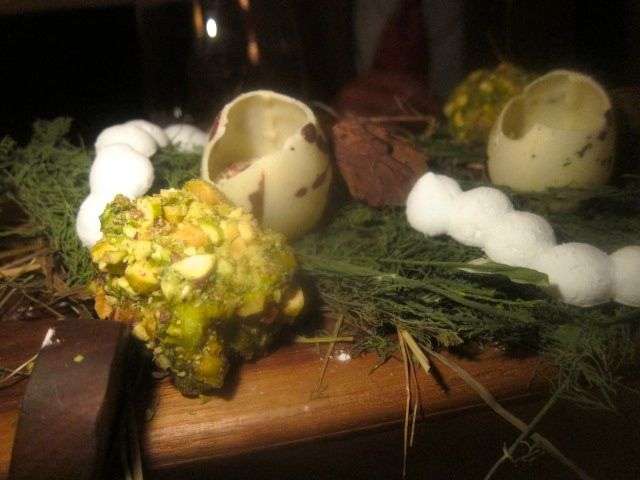 Marisa nibbles arugula meringue. Michael harvests marshmallow. I devour chocolate truffles.
Marisa nibbles arugula meringue. Michael harvests marshmallow. I devour chocolate truffles. Michael threatens to stop the car at McDonald’s on the highway. We beg him to head on home. I’m sure the chef meant well, possibly padding our meal with rare botanicals because it was me, but 29 courses, even though mostly shoots and leaves, can be filling as well as tedious. Marisa is cheerier. She says she might come back in summer when the harvest is so lush. She is not alone. The place is booked far ahead and its champions on the internet write odes to the perfect service and the roller coaster of adventure. Obviously, it’s not for me. Except the bread. I’d have bought a loaf for breakfast and some for friends. Of course, I admire Dan Barber’s fire to save the world. I’ll hope that his Barber wheat thrives in drought and he wins a Nobel Prize, and all those who have thrilled at the Blue Hill opera send their friends.
630 Bedford Road. Pocantico Hills, New York 914 366 9600 Dinner Wednesday through Saturday 5 to 10 pm. Sunday 1 to 10 pm.
Photos may not be used without permission of Gael Greene. Copyright 2014. All rights reserved.
Click here to return to BITE listings. Click here to follow my twitterings. Click here to see my vintage evening bag collection on Etsy.